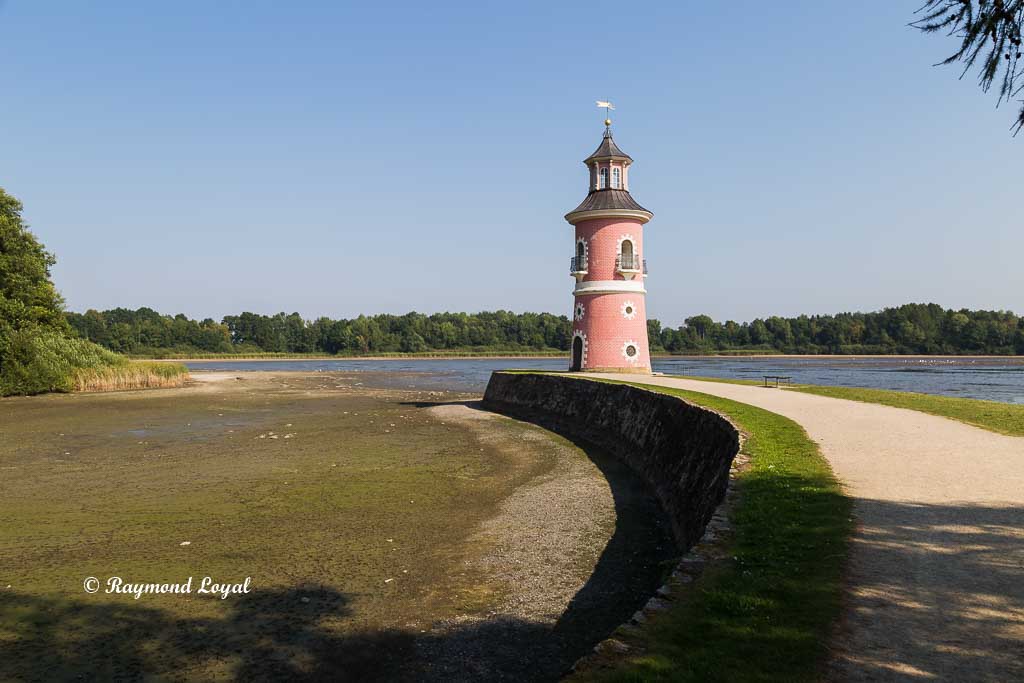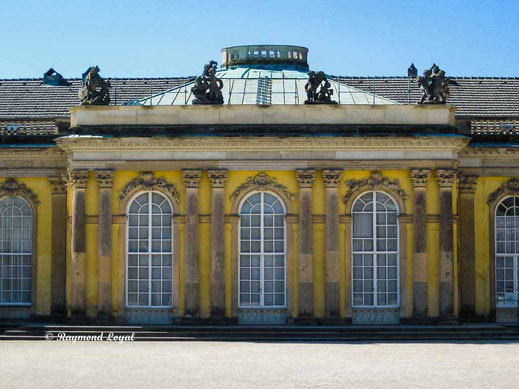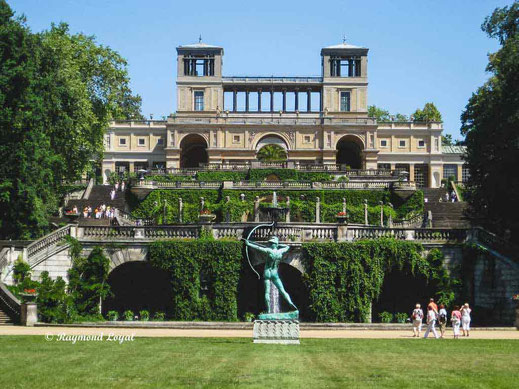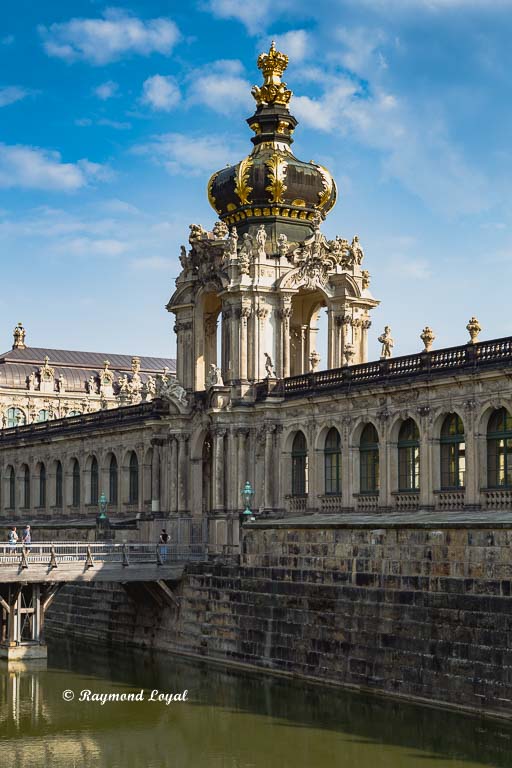Palaces, Castles & Gardens Photography
The landscape photography on this site is all about living in the countryside and shows manors, palaces, castles and gardens from the photographers point of view and provides information on the locations shown on this site..
Also, this site shows interesting photographic locations to give inspiration to the traveller.

Moritzburg Palace
Moritzburg Palace is situated to the north of Dresden and is only a few minutes drive by car from Dresden city centre to the village of Moritzburg.
Moritzburg Castle
Moritzburg castle as we know it today is a baroque palace. The castle or Moritzburg Palace is situated in the identically named village of Moritzburg only 15 minutes afar from Dresden when you travel by car.
The original Castle Moritzburg was designed by the then Duke Moritz of Saxony as a hunting lodge sitting on a granite spot in the middle of a small lake. The castle was built between 1542 and 1546 in the middle of a vast area of woodlands and lakes which served as the dukes hunting grounds for him and his court.
Since its first completion in 1546 the castle underwent a couple of extensions. In 1661 a palace chapel was added to the building, initiated by Duke John George II of Saxony. Though, the substantial reconstruction which transformed the castle into the palace we know today was ordered by Prince-Elector August the Strong Duke of Saxony. T´he reconstruction work started in 1723 and transformed the castle into a baroque maison de pleasance and hunting palace.
It is interesting to know that such palaces where quite popular with neighbouring princes. For example the Prince-Elect and King in Prussia also was proud of his hunting castle in Koenigswusterhausen near Berlin, though, his castle was not as magnificent as that of his Saxon colleague.
Moritzburg Castle sits in the middle of a lake and can be accessed over a paved avenue. The castle is open to visitors and also the adjacent gardens and woods are open to visitors 24/7.
The red-coloured roofs and the white-ochre-coloured paint perfectly blends the castle into the countryside. From the banks of the lake it is possible to capture the castle and the buildings reflections in the water of the lake. Also from the gardens at the back of the castle there are good opportunities to take good shots of the building.
Starting form the rear of the building the visitor enters into the gardens and woods of the castle. From there a number of interesting places can be accessed such as Hellhaus, Venus Fountain, Pheasant Manor (Fasanenschloesschen) and the lighthouse Moritzburg to name but a few.
Arrival by car
Arrival by car is easy and possible. Along the roads circumventing the castle there are five rather large car parks which are open to motorists. Please note that the parking at the entrance to the castle is subject to charges.
Co-ordinates Moritzburg Castle
51°10'00.6''N 13°40'45.4''E
Co-ordinates Parkings near Moritzburg Castle
Parking at Moritzburg Castle:
Parking Perlhühnerscheune:
Parking Kutschketeich:
Parking Kalkreuther Str.
5M9F+WC Moritzburg
Parking Radeburger Str.
Pillnitz Palace Dresden
Palace Pillnitz is the baroque summer residence of August the Strong where he and is court spent the summer months from where he conducted his state business during that time.
The palace was built between 1720 and 1722 and is well-known for its picturesque buildings and the beauty of the palace gardens. The gardens of Palace Pillnitz are open to visitors. A private jetty belongs to the palace which was used by August the Strong when he travelled between Dresden and his summer residence. The jetty is still there and accessible for the palace is sitting on the banks of the river Elbe.
Baroque Garden Gross-Sedlitz
The baroque garden Gross-Sedlitz is situated southeast of the city of Dresden and on the left banks of the river Elbe. Gross-Sedlitz itself is part of the City of Heindenau.
The entire site consits of Frederic Castle, the upper and lower orangery and the adjacent gardens. Castle and gardens are designed in a baroque sort of style and are among the best preserved baroque gardens in Germany. Also, Gross-Sedlitz is one of best known French style baroque gardens.
Castle and gardens were built between 1719 and 1723 for August Count of the Empire Wackerbarth as country residence. Castle and orangery are very similar to the style of Moritzburg Palace. Little wonder as August the Strong bought the castle and the estate in 1823 already.
It is only a few minutes walk from the entry to the upper orangery and the castle. Flights of stairs lead down to the lower orangery and the gardens. In front of the lower orangery there are water gardens situated to enjoy the visitor. The entire garden in front of the lower orangery is well designed and shows some similarities to the orangery at Sanssouci gardens, considering that construction at Sanssouci commenced in 1745 only.
From a hight cascades are constructed to let water flow down into the gardens. A great water basin is at the end of the cascades. The site is no longer working and partly covered with lawn.
Arrival and Address
The address of the Baroque Garden:
Parkststraße 85
01809 Heidenau
Coordinate: XV2Q+FH Heidenau
Photographers travelling with extensive equipment can park their car closely to the entrance.






Sanssouci Palace
Sanssouci Palace was the summer residence of the Prussian King Frederick the Great (Frederick II). Sanssouci Palace is a palace built in the rococo style constructed after the kings own sketches. It is to be mentioned that Frederick gathered inspiration from his visits to other palaces and gardens which made him design and built a palace and gardens which are still second to none, with the exception of Versailles,
The construction of the palace started in 1745 and was completed in 1747.
The palace is connected to a spacious park and garden to which a the large Orangery Place belongs as well as other highly interesting sites such as the Chinese Teahouse, The Church of Peace (Friedenskirche), the historic windmill, the antiques temple to name but a few.
In front of the palace are the Vineyard Terraces through which flights of stairs lead down to the gardens. At the end of the stairs a vast fountain is situated.
Following the way from the fountain in a straight direction leads the visitor deeper in the gardens and provides wonderful view of the gardens and installations. Turning back to the palace the view of the fountain and terraces with the palace majesticlyl sitting on top of the terraces are an unique view you will not find elsewhere.
Sans souci is a French wording meaning "Without Sorrow or Fear". History had it that the great king Frederic the Great did not have the benefit of living without any sorrow during his lifetime. Though this pious hope is not without any reason and could be meaningful for everyone who manage to stand on´ top the terraces casting his eye over the vast gardens.
Arriving at Sanssouci Palace
Coming from Berlin use S-Bahn S7 to Potsdam main station. From Potsdam main station the traveller has three options:
- Bus lines 695, X15 to bus stop "Schloss Sanssouci"
- Bus lines 605, 606 or tram 91 and 94 to bus / tram stop "Schloss Charlottenhof"
- Bus lines 605, 606 to bus stop "Potsdam Park Sanssouci"
Visitors coming from outside Potsdam or Berlin and travel by car, use Berlin Orbit motorway A10 , exits "Potsdam Nord", "Michendorf" or "Gross Kreutz".
Motorists coming from Berlin use Heerstrasse and Hamburger Chaussee in the direction of Potsdam;
coming from Halensee travel via motorway A115 until junction Babelsberg and change on to "Nuthestrasse" in the direction to Potsdam Centre;
coming from Berlin Tempelhof, Steglitz or Zehlendorf travel over the B1 via junction Zehlendorf and continue on "Koenigstrasse" in the direction to Potsdam.
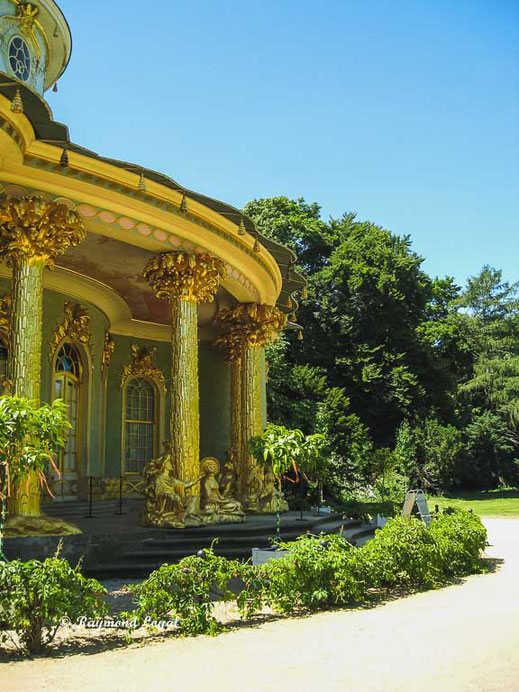
Car Parks at Sanssouci Park
There are two car parks available near the entrance to Sanssouci Park. Just follow the signposts. Parking is subject to charges.
Parking 1 next to the Historic Windmill
Co-ordinates:
52°24'17.2''N 13°03'04.9''E
Distance to the ticket counter is about 2 to 5 minutes walk.
Parking 2 Voltairweg
Co-ordinates:
52°24'26.2''N 13°02'47.2''E
Distance to the ticket counter is about 12 minutes (max) walk.

Chinese Teahouse at Sanssouci Palace
The Chinese Teahouse is a garden pavilion at Sanssouci Park erected under Frederic the Great as sort of an additional ornament to the gardens. Construction of the pavilion began in 1755 and was completed in 1564. The style of the pavilion is a mixture between rococo and far-east architecture. Construction of the pavilion was hampered by the 7-year-war which mostly brought construction to a standstill. Only after the end of the war the interior was completed.
The images show some of the Chinese sculptures that decorate the outside walls of the pavilion.
Orangery Palace at Sanssouci Park
The Orangery Palace at Sanssouci Palace Gardens is situated north of Maulbeerallee and only a few minutes foot walk from Sanssouci Palace. Construction of the Orangery Palace took place between 1851 and 1864, by order of the then Prussian King Frederic William IV. The building consists of the central palace element, extended by two huge garden halls, one on each side. Even today the garden halls are home to a great variety of plants. Above the garden halls there are still the regent's residences and the servant's lodgings.
From the Orangery Palace down in a southern direction there are the Orangery Terraces which extend crossing Maulbeerallee. In the continuation of that line the visitor will find a fountain and south of the fountain there is an Apollo statue depicting Apollo as an archer. Please find images of that below.
Palace Festetics
Festetics Palace is a baroque palace in the Hungarian town of Keszthely. The town is closely situated to lake Balaton.
Das Schloss Festetics ist ein Barockschloss in der ungarischen Stadt Keszthely. Der Ort Keszthely liegt in kurzer Entfernung zum Plattensee (Balaton).
Festetics Palace is the third largest palace in Hungary and also ranks high when it comes to visitor numbers. The visitor coming to Festetics first time will most certainly think about the palace of Versailles in France. This is due to the architecture of the buildings, the style of the roof and of course to the palace gardens. One could call Festetics little Versailles.
The construction of the palace began in 1745 and the first completion was in 1770. A first re-construction was in 1792. Though, substantial re-construction work did happen between 1883 and 1887 which established the palace as the building we know of today.
The Zwinger Palace Dresden
The Zwinger is a palatial complex with a palace garden in the centre of Dresden consisting of ppavillons, galleries, and the Semper Gallery which closes the complex towards Theater Square and the Semper Opera House.
The main address of the Zwinger is Sophienstrasse, 01067 Dresden.
One of the frequently asked questions is: Where does the term "Zwinger" come from? Zwinger is sort of a military term and relates, in the early days, to castle construction, and later to fortress construction and describes an area between two defensive walls. Usually these walls were the lower outer wall and the higher inner wall of a castle of fortress. A Zwinger built around town gates is usually a well fortified area around a system of gates.
The Zwinger Palace is actually constructed on the foundations of the old Zwinger of Dresden. The "Kronentor" (Crown Gate) of the Zwinger still stands at the place of the historical town gate.
The Saxon Prince-Elector August the Strong had designed the Zwinger as the forecourt of a new palace he wanted to build on the banks of the river Elbe. This is why the Zwinger originally only had a small baroque wall on the eastern side. However, the new palace, August the Strong had made plans for, was never build during his life time and his successors discarded any plans for a new palace entirely.
The Zwinger has three gates, the "Kronentor" (Crown Gate) on the western side, the "Glockenpavillon" (Bell Gate) on the southern side and the gate in the "Sempergalerie" (Semper Gallery). There is no gate on the northern side of the Zwinger. Except for general lockdowns, the gates are open 24/7 for the public.
There is the palace garden "Zwingergarten" situated in the court of the palatial area. The Zwinger garden changed its appearance several times over the centuries. The look we know nowadays stems from the last re-construction of the Zwinger after the end of WW II and after German re-union in 1990.
Also the buildings of the Zwinger are re-constructions as the Zwinger was raized to the ground during Allied carped bombing raids on Dresden in February 1945. It must be said that the people of Dresden did not waste much time and started rebuilding the Zwinger in 1945 already and completed construction work in 1951.
The Dresden Zwinger is one of the most popular tourist sights in Dresden and as popular as Dresden Frauenkirche.









